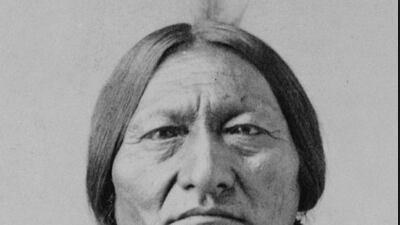Another Cinco de Mayo anniversary:
On May 5, 1877, Sitting Bull led his warriors to refuge in Canada after the Battle of Little Big Horn. What happened next …
In the fall of 1876, Colonel Nelson A. Miles met with Sitting Bull at a neutral location and tried to talk him into surrendering and relocating to a reservation. Although anxious for peace, Sitting Bull refused. As the victor of the Battle of the Little Big Horn, Sitting Bull felt he should be dictating terms to Miles, not the other way around.
ADVERTISEMENT
Angered by what he saw as Sitting Bull's foolish obstinacy, Miles stepped up his campaign of harassment against the chief and his people. Sitting Bull's band continued to roam about Montana in search of increasingly scarce buffalo, but the constant travel, lack of food, and military pressure began to take a toll. On this day in 1877, Sitting Bull abandoned his traditional homeland in Montana and led his people north across the border into Canada.
Sitting Bull and his band stayed in the Grandmother's Country-so called in honor of the British Queen Victoria-for the next four years. The first year was idyllic. The band found plenty of buffalo and Sitting Bull could rest and play with his children in peace. The younger warriors, though, soon tired of the quiet life. The braves made trouble with neighboring tribes, attracting the displeasure of the Canadian Mounties. While the Canadian leaders were more reasonable and sensitive about Indian affairs than their aggressive counterparts to the south, they became increasingly nervous and pressured Sitting Bull to return to the U.S.
Ultimately, though, Sitting Bull's attempt to remain independent was undermined by the disappearance of the buffalo, which were being wiped out by Indians, settlers, and hide hunters. Without meat, Sitting Bull gave up his dream of independence and asked the Canadian government for rations. Meanwhile, emissaries from the U.S. came to his camp and promised Sitting Bull's followers they would be rich and happy if they joined the American reservations. The temptation was too great, and many stole away at night and headed south. By early 1881, Sitting Bull was the chief of only a small band of mostly older and sick people.
Finally, Sitting Bull relented. On July 10, 1881, more than five years after the fateful battle at the Little Big Horn, the great chief led 187 Indians from their Canadian refuge to the United States. After a period of confinement, Sitting Bull was assigned to the Standing Rock reservation in South Dakota in 1883. Seven years later he was dead, killed by Indian police when he resisted their attempt to arrest him for his supposed participation in the Ghost Dance uprising.






